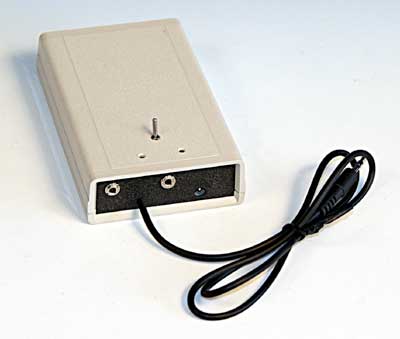 The GPS Reference Receiver is a MicroSet accessory for people who need to measure high precision timepieces over weeks or months at a time. It consists of a GPS receiver, power supply, antenna, and a microprocessor interface to the MicroSet Clock Timer.
The GPS Reference Receiver is a MicroSet accessory for people who need to measure high precision timepieces over weeks or months at a time. It consists of a GPS receiver, power supply, antenna, and a microprocessor interface to the MicroSet Clock Timer.
Though GPS receivers are usually used to tell you where you are, some of them also provide a highly accurate time reference. The GPS Reference Receiver provides a one second pulse derived from the GPS satellites that is accurate to one microsecond. This can be used by itself to calibrate your timer. But you can also plug a MicroSet optical sensor into the Reference Receiver and, with MicroSet, measure the drift of a precision one second pendulum relative to the reference signal. This allows you to detect drift as small as millionths of a second over any interval of time: hours, days, weeks, or months. Because the GPS reference signal does not vary by more than one microsecond, the the maximum error of your measurements is equally small (see note below). And because the reference signal is immune to local temperature changes, it's an ideal way to measure subtle thermal effects on your clocks.
GPS receivers must have a special antenna to receive signals from the satellites they use. An appropriate antenna (shown below) is included with the Reference Receiver. This antenna works best with a clear view of the sky. It may not work indoors unless it is next to a window. Even then it may lose the satellite signals periodically. This will not interfere with your measurements if it happens for short periods because the internal timebase of the GPS receiver is trimmed to be accurate when the satellites are not in view. When the signal is restored, it is in perfect phase with the original signal. If you locate the antenna outside with a clear view of the sky you can be assured of uninterrupted reception.
 The GPS Reference Receiver also has a jack for the standard MicroSet computer interface cable. This allows you to plug the GPS Reference into a Windows computer. A program is included that displays statistics about the GPS data including number of satellites seen, accuracy of reception, longitude, latitude, Coordinated Universal Time, and local time. This allows you to evaluate the performance of the GPS receiver at your location.
The GPS Reference Receiver also has a jack for the standard MicroSet computer interface cable. This allows you to plug the GPS Reference into a Windows computer. A program is included that displays statistics about the GPS data including number of satellites seen, accuracy of reception, longitude, latitude, Coordinated Universal Time, and local time. This allows you to evaluate the performance of the GPS receiver at your location.
If you have the MicroSet Windows Interface Software version 2 or 3 you can also get an update that will create a MicroSet graph of the performance of the receiver. This allows you to record the performance over a day or two and see how often you lost satellite "lock" and for how long. This allows you to find the most reliable location for your GPS antenna.
The GPS Reference Receiver includes the following:
- Garmin GPS receiver
- Motorola "hockey puck" GPS antenna
- Data cable to MicroSet
- Sensor jack for a MicroSet optical sensor
- Interface jack for MicroSet computer interface cable
- AC adaptor
- Windows computer program to monitor the GPS data
- LED which blinks on each reference pulse
- LED which blinks on each swing of the pendulum
- Toggle switch to select between measuring the clock drift and direct output of the GPS reference pulse.
The GPS Reference Receiver requires the MicroSet Clock Timer. It can be used without the computer interface software and will display the current offset between your timepiece and the reference signal on the MicroSet LCD screen. It is more useful to use the GPS Reference Receiver with the MicroSet Windows Interface software versions 2 or 3. These programs have a GPS menu so that you can record the drift of your clock over time and convert the drift data into absolute rate values.
The GPS Reference Receiver has been superceded by the GPS Mode in MicroSet. It functions the same, but the hardware has been simplified.